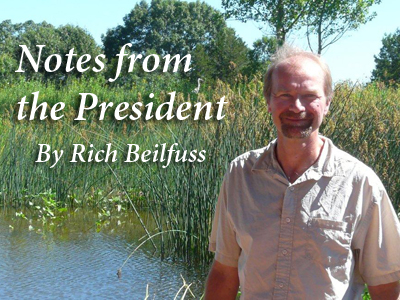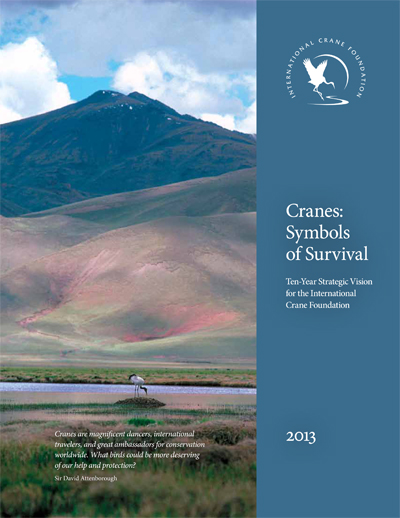This update is reprinted from the February 2013 issue of The ICF Bugle
 Forty Years! The advent of our 40th anniversary is an important time to reflect on our many achievements, to assess the conservation challenges that lay ahead, and to chart a clear course for the future. From the beginning, ICF recognized that conserving all 15 species of cranes requires a broad commitment to the people and places essential to cranes. Over the past four decades we have grown dramatically in global reach and impact, while steadily developing our capacity to address the health of the landscapes that sustain not only cranes, but also people and a wealth of biodiversity. Cranes truly are ambassadors for conservation – serving both as sentinels and flagships for some of the most important places on Earth.
Forty Years! The advent of our 40th anniversary is an important time to reflect on our many achievements, to assess the conservation challenges that lay ahead, and to chart a clear course for the future. From the beginning, ICF recognized that conserving all 15 species of cranes requires a broad commitment to the people and places essential to cranes. Over the past four decades we have grown dramatically in global reach and impact, while steadily developing our capacity to address the health of the landscapes that sustain not only cranes, but also people and a wealth of biodiversity. Cranes truly are ambassadors for conservation – serving both as sentinels and flagships for some of the most important places on Earth.
Crane conservation remains a daunting challenge
Cranes are among the most endangered families of birds in the world, with eleven of the fifteen species threatened with extinction. In sub-Saharan Africa, Grey Crowned, Black Crowned, Wattled, and Blue Cranes face many threats fueled by population growth and widespread poverty. In Asia, six species are threatened, including Siberian, Red-crowned, White-naped, Hooded, and Black-necked Cranes in rapidly developing East Asia, and the Sarus Crane throughout its range in South and Southeast Asia. The rarest of all cranes, the Whooping Crane, faces an array of conservation and reintroduction challenges here in North America.
Crane conservation inspires big thinking
When ICF was founded 40 years ago, we were only beginning to understand the magnitude of the ecological crises posed by global population growth, water scarcity, energy demand, climate change, and other 21st century challenges. To save cranes, we must engage in finding sustainable pathways for water, land, and energy development, securing biodiversity on agricultural lands, enabling communities to benefit in meaningful and lasting ways through conservation action, and adapting to new climate realities. We must continue to bring people together to create models that demonstrate real conservation solutions, based on sound science and long-term commitments to the people and places where we work.
Conservation leadership is key
ICF is a small organization with a big mission. By focusing on threatened cranes (and their universal appeal), we seek to mobilize a global community of dedicated and resourceful people for a direct and lasting impact on the environment. A unique strength of ICF has been the mentoring and inspiration we have provided to budding conservationists around the world. Here in Baraboo and in the most important crane landscapes around the world, we provide the training and resources that local leaders need to engage their communities in positive change.
 I am pleased to announce the release this month of Cranes: Symbols of Survival. This beautiful and informative report describes the outcomes of our recent strategic planning process, aimed at taking ICF to a new level of conservation leadership and success. We describe the essential conditions for crane conservation, as a road map from our past to our future. We outline our conservation strategies, and provide our vision and key initiatives for priority programs over the next decade.
I am pleased to announce the release this month of Cranes: Symbols of Survival. This beautiful and informative report describes the outcomes of our recent strategic planning process, aimed at taking ICF to a new level of conservation leadership and success. We describe the essential conditions for crane conservation, as a road map from our past to our future. We outline our conservation strategies, and provide our vision and key initiatives for priority programs over the next decade.
One of the joys in preparing this report was the opportunity for our partners and supporters to reflect on how ICF has affected their lives. From Kenya , Maurice Wanjala of the Kipsaina Crane and Wetland Conservation Group wrote, “With support from ICF and others, my community group is working to stop wetland destruction. We help local communities farm organically, fish sustainably, produce bee products, and create and sell handicrafts – all wetland friendly practices. Through our efforts, we have reversed the trend of destruction and restored many wetlands to health.” And longtime supporter and ICF Director Bob Dohmen added, “Supporting the work of ICF is a natural extension of our family’s deep connection to the African continent. Under the flagship of cranes, we are helping improve environmental and living conditions for the benefit of people and wildlife for generations to come.”
Our 40th anniversary is dedicated to our many partners who make our work possible. Thank you for your commitment to saving cranes.
